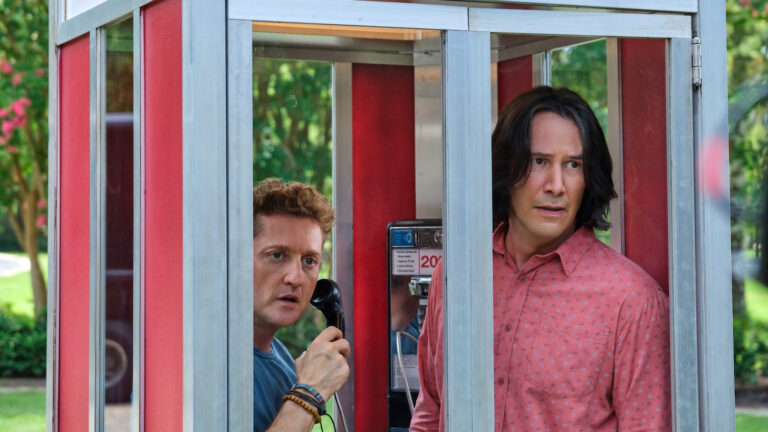This tidal wave of production has resulted in tons of jobs, swelling the ranks of the International Alliance of Theatrical and Stage Employees (IATSE) Local 480. But these union jobs consist primarily of “below the line” talent: well-paid grunt labor in the form of grips, gaffers, cable haulers and production assistants. New Mexico, being the great artistic wellspring that it is, is flush with writers, producers and directors. What is being done to help this homegrown “above the line” talent?
Earlier this year, the Alibi asked that very question of Gov. Bill Richardson, a politician who has gone out of his way to court Hollywood. Richardson responded by asking what we would do to encourage local filmmakers. We told him. And he agreed with us. Turns out Richardson has been working with the State Film Office for some time now in an effort to channel some of those Hollywood dollars toward helping local filmmakers.
“Our mission obviously is about jobs,” says Lisa Strout, director of the Film Office. “These are very, very good jobs. If you are a local filmmaker and you make a career and you bring a lot of people along with you in that career, it becomes more of a sustainable industry here. We all agree on that. Our mission has always been not about ’Hollywood' or ’local' but about creating satisfying, well-paying jobs that will improve lives.”
Still, it has proved difficult for underfunded local filmmakers to maneuver through the maze of state agencies in search of help. Directors looking to shoot in “free” state buildings might run into expensive insurance issues. Filmmakers asking the Legislature for help in promoting a New Mexico film might be ignored. One of the biggest moves toward helping local talent came with the hiring of Jodi Delaney, who is now the State Film Office's “program director for NM filmmakers.”
“I came on in January,” says Delaney from her office in Santa Fe. “I'm really here to nurture New Mexico-based ’above the line' talent. In the last three months that I've been here, my job [has been] to implement these programs that we've come up with and hopefully just make this hill a little easier to climb. This is a difficult business no matter where you live. We can't solve everybody's problems, but I'm hoping we can help.”
In late February, the Alibi helped out by setting up a meeting in Albuquerque between Gov. Richardson, the State Film Office and a dozen local filmmakers. For an hour and a half the governor fired off pointed questions asking the filmmakers to “give me something concrete” that he and his administration could provide.
“I thought it was fantastic to have the governor there himself in a small, more intimate venue,” says Strout. “I felt that the end result was there was a new relationship built from that meeting between the state and local filmmakers. We've been getting lots of e-mail from folks that were in that meeting. There was good dialogue. … That's just one tiny little step, but I felt it was the beginning of a new relationship which is really healthy and productive.”
That meeting at the Alibi offices led directly to the governor's March 17 press conference, in which he announced a $500,000 addition to the New Mexico Filmmaker's Program. This initial amount, which the governor frequently referred to as “a down payment,” is earmarked primarily for grants. These grants can be used by filmmakers to develop scripts, complete films and fund postproduction.
The money comes from the state's Media Fund, a multimillion-dollar fund set aside by the Legislature to promote emerging digital media as well as conventional film and television. Strout elaborates: “There is a focus on what [the governor] was calling ’grants,' because that's the word everyone responds to.” Unfortunately, New Mexico state law prevents the state from issuing straight grants. All monies given out must benefit the state in some direct way. In the future, this anti-donation clause may have to be amended. In the meantime, says Strout, “It may change to ’contract awards.' We've talked for a long time about grants and anti-donation and all of that. The point is that you must be serving the state somehow. That's the difference between a grant and what this is.” Despite the legislative juggling, Strout believes the grants will be successful, because promoting local film ultimately “does serve the state.”
In addition to the grants, the state is sponsoring the Governor's Cup Screenwriting Challenge. The deadline for submission is this Friday, April 7. The Film Office has already received 100 submissions. Four of those 10-page screenplays will be chosen to be shot here in New Mexico on the state's dime. Like the work that will eventually be produced by the governor's filmmaking grants, the state will not retain rights to the product.
“That is not our goal,” says Strout. “We'll succeed much better allowing filmmakers to retain ownership. … Jodi and I are very much in agreement that the purpose is not for the state to own these. We want the local film community to succeed as best they can, and making money would be fantastic because you can make more films.”
In addition to the financial subsidies, the governor also announced at his press conference that the State Film office would be moving out of its current location in Santa Fe's administration-heavy Joseph Montoya Building and into the recently closed Jean Cocteau Cinema. There, the Film Office will share space with the long-gestating New Mexico Film Museum.
Strout believes the Jean Cocteau will afford the film office the sort of creative atmosphere it's been lacking. “In the old days, the office used to be on Old Pecos Trail by CCA. People miss that. I've heard that for five years, that people miss us being in a location that was more artistic and that felt friendly. Not that we're not friendly in the Montoya Building; but it's just not the same, to go to a large building that also has Tax & Revenue in there.” According to Stout, the new building “feels like a home for creativity.”
Plus, as Delaney points out, it's got a great big movie screen in it–just the sort of place to premiere all those locally made films.
The new building also allows the Film Office to expand its resource room, a combination workshop/lending library/meeting space that will hopefully function as one of the cornerstones of our state's indie filmmaking scene. “I want to see what kind of gear we can get,” says Delaney, rolling over the possibilities in her mind. “It would be nice to have at least a couple of editing suites. Some place to do animation, or at least do the tutorials. Right now, we have some screenwriting software, we have Movie Magic budgeting and scheduling. What I want in there are things that are very practical. A library of seminars. Maybe I can get my hands on some sound effects. Things that people can really use if they don't have the means to get it themselves.”
It would seem as if the state's new liaison for local filmmakers has her year's work cut out for her. Delaney lays it out like this, “If you want some chronology, the New Mexico Filmmakers Showcase is in May. This month we're selecting the Governor's Cup winners. Those will be shot in June. In July we move, so I'll have the summer to get the resource center together. I want to try and have some kind of grand opening for that this fall, hopefully September/October. Which, at the same time, we'll be getting the contract awards together. So, yeah, there's a lot happening.”
To contact the State Film Office or to find out more about the Governor's Cup Screenwriting Challenge, the New Mexico Filmmakers Week or the upcoming contract awards, log on to www.nmfilm.com.



